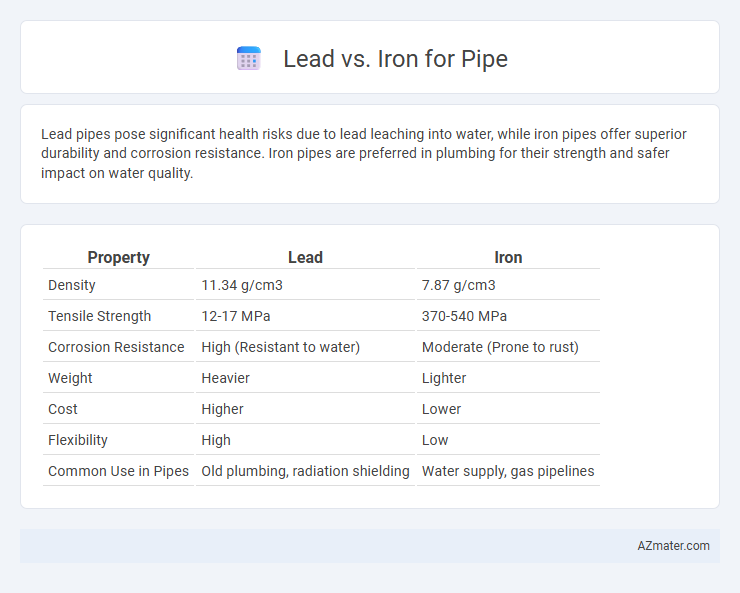Lead pipes pose significant health risks due to lead leaching into water, while iron pipes offer superior durability and corrosion resistance. Iron pipes are preferred in plumbing for their strength and safer impact on water quality.
Table of Comparison
| Property | Lead | Iron |
|---|---|---|
| Density | 11.34 g/cm3 | 7.87 g/cm3 |
| Tensile Strength | 12-17 MPa | 370-540 MPa |
| Corrosion Resistance | High (Resistant to water) | Moderate (Prone to rust) |
| Weight | Heavier | Lighter |
| Cost | Higher | Lower |
| Flexibility | High | Low |
| Common Use in Pipes | Old plumbing, radiation shielding | Water supply, gas pipelines |
Introduction to Lead and Iron Pipes
Lead pipes, historically used for water supply due to their malleability and corrosion resistance, pose significant health risks like lead poisoning. Iron pipes, predominantly cast iron or ductile iron, are favored for their durability, strength, and resistance to high pressure, making them standard in modern water and sewage systems. Understanding the material properties and health implications of both lead and iron pipes is crucial for safe plumbing infrastructure.
Historical Use of Lead and Iron in Plumbing
Lead and iron have historically been prevalent materials in plumbing, with lead pipes widely used by ancient Romans due to their malleability and resistance to corrosion. Cast iron later became popular in the 19th and early 20th centuries for its durability and strength in water and sewage systems. However, the discovery of lead's health risks led to the gradual replacement of lead pipes by safer materials, including iron and modern alternatives.
Chemical Properties: Lead vs Iron
Lead exhibits excellent corrosion resistance due to its inert nature and low reactivity with water and air, making it less likely to rust compared to iron. Iron, particularly when exposed to moisture and oxygen, readily undergoes oxidation, forming iron oxide (rust), which compromises its durability in piping applications. The chemical stability of lead in acidic and alkaline environments contrasts with iron's susceptibility to corrosion, influencing their suitability for different pipe systems.
Durability and Longevity Comparison
Lead pipes historically offered flexibility and corrosion resistance but face significant health hazards due to lead contamination risks. Iron pipes, particularly cast iron and ductile iron, exhibit superior durability with resistance to high pressure, mechanical stress, and longer service life exceeding 50 years in optimal conditions. Modern standards favor iron pipes over lead for water infrastructure due to enhanced longevity, structural integrity, and compliance with health regulations.
Health Risks: Lead Pipes vs Iron Pipes
Lead pipes pose significant health risks due to lead leaching into drinking water, causing neurological damage, especially in children and pregnant women. Iron pipes, while less toxic, can corrode and release iron particles that affect water taste and quality but generally do not cause severe health issues. Regular water testing and pipe replacement are essential to mitigate these risks in aging plumbing systems.
Environmental Impact of Lead and Iron Pipes
Lead pipes pose significant environmental risks due to lead leaching into water supplies, causing toxic contamination harmful to human health and aquatic ecosystems. Iron pipes, while more environmentally stable, can corrode and release rust particles, impacting water quality but generally posing fewer health hazards compared to lead. The widespread phase-out of lead pipes reflects regulatory efforts to mitigate lead pollution and promote safer, more sustainable plumbing materials.
Installation and Maintenance Differences
Lead pipes require specialized safety measures during installation due to lead's toxicity, demanding protective equipment and strict handling protocols. Iron pipes, typically ductile or cast iron, are heavier and need tools for cutting and threading, while lead pipes can be shaped more easily by hand. Maintenance of lead pipes involves monitoring for corrosion and potential lead leaching, whereas iron pipes require regular inspection for rust and corrosion buildup, often necessitating treatments or replacement over time.
Cost Analysis: Lead vs Iron Pipes
Iron pipes typically have higher initial costs due to material and installation expenses compared to lead pipes, which are cheaper upfront but present significant health risks. Maintenance and replacement costs for lead pipes can escalate over time because of corrosion and contamination issues, whereas iron pipes generally offer longer durability and lower lifecycle expenses. Cost analysis favors iron pipes for long-term investment despite their higher initial price, considering health safety regulations and potential remediation expenses associated with lead.
Regulatory Standards and Restrictions
Lead pipes are strictly regulated and often banned due to their toxicity and health risks, with standards like the U.S. Safe Drinking Water Act limiting lead content in plumbing materials. Iron pipes, including ductile and cast iron, comply with EPA and NSF/ANSI 61 certifications, ensuring safe drinking water use without heavy metal leaching concerns. Regulatory agencies mandate iron pipes over lead in potable water systems to prevent lead contamination and protect public health.
Modern Alternatives to Lead and Iron Pipes
Modern alternatives to lead and iron pipes include copper, cross-linked polyethylene (PEX), and chlorinated polyvinyl chloride (CPVC), which offer improved safety and durability. Copper pipes resist corrosion and have excellent thermal conductivity, making them ideal for potable water systems. PEX and CPVC provide flexibility, ease of installation, and resistance to chemical degradation, reducing risks associated with lead contamination and iron pipe corrosion.

Infographic: Lead vs Iron for Pipe
 azmater.com
azmater.com